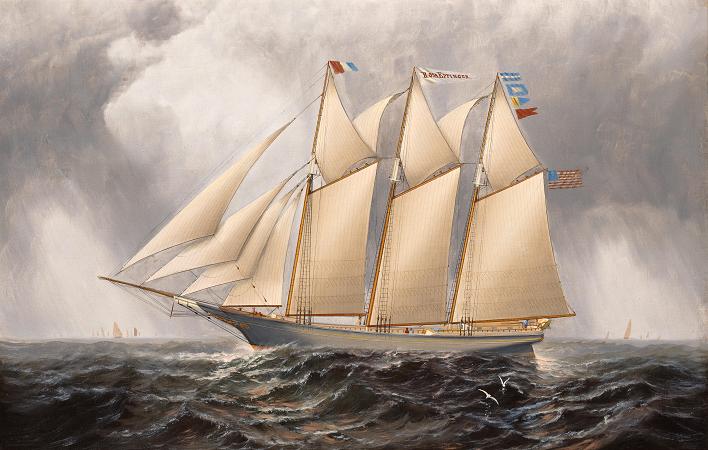Fitz Henry Lane (1804 - 1865). Fitz Henry Lane was born on December 19, 1804, in Gloucester, Massachusetts. Lane was christened Nathaniel Rogers Lane on March 17, 1805, and would remain known as such until he was 27. It was not until March 13, 1832, that the state of Massachusetts would officially grant Lane's own formal request to change his name from Nathaniel Rogers to Fitz Henry Lane. As with practically all aspects of Lane's life, the subject of his name is one surrounded by much confusion, it was not until 2005 that historians discovered that they had been wrongly referring to the artist as Fitz Hugh, as opposed to his chosen Fitz Henry. The reasons behind Lane's decision to change his name, and for choosing the name he did, are still very unclear; although, one suggestion is that he did it to differentiate himself from the well-known miniature painter Nathaniel Rodgers. From the time of his birth, Lane would be exposed to the sea and maritime life, a factor that obviously had a great impact on his later choice of subject matter. Many circumstances of his young life ensured Lane's constant interaction with various aspects of this maritime life, including the fact that Lane's family lived upon the periphery of Gloucester Harbor's working waterfront, and that his father, Jonathan Dennison Lane, was a sailmaker, and quite possibly owned and ran a sail loft. It is often speculated that Lane would most likely have pursued some seafaring career, or become a sail-maker like his father, instead of an artist, had it not been for a lifelong handicap Lane developed as a child. Although the cause cannot be known with certainty, it is thought that the ingestion of some part of the Peru-Apple, a poisonous weed also known as jimsonweed, by Lane at the age of eighteen months caused the paralysis of the legs from which Lane would never recover. Furthermore, it has been suggested by art historian James A. Craig that because he could not play games as the other children did, he was forced to find some other means of amusement, and that in such a pursuit he discovered and was able to develop his talent for drawing. To go a step further, as a result of his having a busy seaport as immediate surroundings, he was able to develop a special skill in depicting the goings-on inherent in such an environment. Lane could still have become a sail-maker, as such an occupation entailed much time spent sitting and sewing, and that Lane already had some experience sewing from his short-lived apprenticeship in shoe-making. However, as evidenced in this quote from Lane's nephew Edward Lane's Early Recollections, his interest in art held much sway in his deciding on a career: Before he became an artist he worked for a short time making shoes, but after a while, seeing that he could draw pictures better than he could make shoes he went to Boston and took lessons in drawing and painting and became a marine artist. Lane acquired such lessons by way of his employment at Pendleton's Lithography shop in Boston, which lasted from 1832 to 1847. With the refinement and development of his artistic skills acquired during his years working as a lithographer, Lane was able to successfully produce marine paintings of high quality, as evidenced in his being listed, officially, as a marine painter in the Boston Almanac of 1840. Lane continued to refine his painting style, and consequently, the demand for his marine paintings increased as well. Lane had visited Gloucester often while living in Boston, and in 1848, he returned permanently. In 1849, Lane began overseeing construction of a house/studio of his own design on Duncan's Point, this house would remain his primary residence to the end of his life. Fitz Henry Lane continued to produce beautiful marine paintings and seascapes into his later years. He died in his home on Duncan's Point on August 14, 1865, and is buried in Oak Grove Cemetery. However ambiguous many aspects of Lane's life and career may remain, a few things are certain. First, Lane was, even in childhood, clearly gifted in the field of art. As was noted by J. Babson, a local Gloucester historian and contemporary in Lane's time, Lane showed in boyhood a talent for drawing and painting; but received no instruction in the rules till he went to Boston. In addition to confirming Lane's early talent, this observation also indicates that Lane was largely self-taught in the field of art, more specifically drawing and paintings, previous to beginning his employment at Pendleton's lithography firm at the age of 28. Lane's first-known and recorded work, a watercolor titled The Burning of the Packet Ship Boston, executed by Lane in 1830, is regarded by many art historians as evidence of Lane's primitive grasp of the finer points of artistic composition previous to his employment at Pendleton's.
more...














